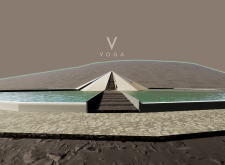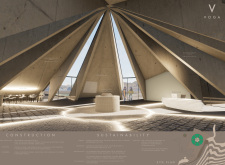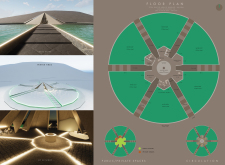5 key facts about this project
The architecture represents a conceptual integration with the volcanic landscape, characterized by a distinctive pyramidal shape that reflects the geological features of nearby formations, such as the Hverfjall Volcano. This connection to the landscape is more than aesthetic; it invites contemplation about geological processes and the natural history of the region, positioning the structure as an extension of the volcanic heritage rather than a mere anthropocentric installation.
Functionally, the project is designed as a visitor center, catering to a variety of public needs. It includes exhibition spaces, educational facilities, and amenities such as a café, all organized to enhance visitor experiences while navigating the site. The layout promotes fluid movement, facilitating easy access to different areas while fostering social interaction. The inclusion of a body of water surrounding the structure serves both practical and symbolic functions, providing ecological benefits while enriching the visual landscape. This thoughtful incorporation of water creates an inviting environment that attracts wildlife and enhances the overall aesthetic appeal.
Key elements of the design include its hexagonal plan, which embodies geometric principles found in nature, particularly in volcanic formations. The choice of reinforced concrete as the primary material was driven by both its durability and adaptability to the local climate. This material is complemented by locally sourced gravel and stone, echoing the colors and textures of the natural surroundings. The architectural design integrates large double-glazed windows, ensuring ample natural light while providing stunning views of the landscape, further blurring the lines between interior and exterior spaces.
This project distinguishes itself through its commitment to sustainability. By harnessing local geothermal energy and implementing efficient waste management systems, the design prioritizes environmental responsibility. Rainwater harvesting adds another layer of sustainability, emphasizing practical approaches to resource management in a region where water conservation is vital.
The interior spaces are thoughtfully curated to reflect the building's intent as an educational and cultural hub. Zones designed for relaxation and learning are interwoven, encouraging not just the consumption of information but also interaction among visitors. The use of natural materials and finishes throughout reinforces the connection to the environment, promoting a sense of place that resonates with the overall design philosophy.
In terms of unique design approaches, the project's integration with its geographical context sets a precedent for future architectural endeavors in sensitive environments. The emphasis on combining natural landscapes with modern needs highlights an important dialogue between architecture and ecology. This building showcases how contemporary architectural practices can respond to local identities while respecting and enhancing the natural world.
For those interested in a deeper exploration of this architectural project, including architectural plans, sections, and innovative design elements, it is encouraged to review the project presentation. These insights will provide a fuller understanding of the thoughtful decisions made throughout the design process and illustrate how this project effectively achieves its objectives in a harmonious manner with its surroundings.


























